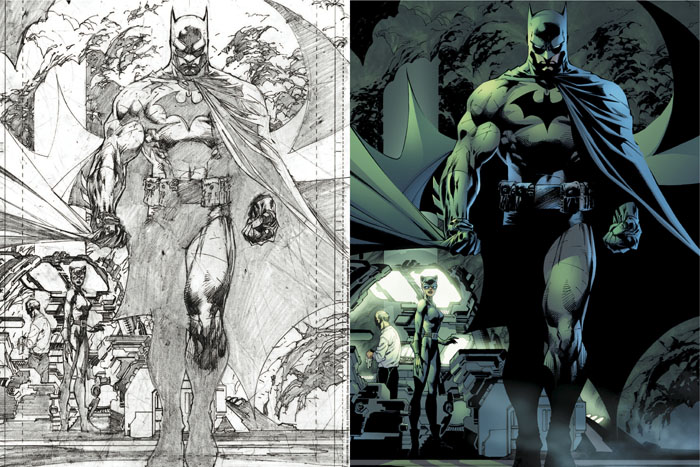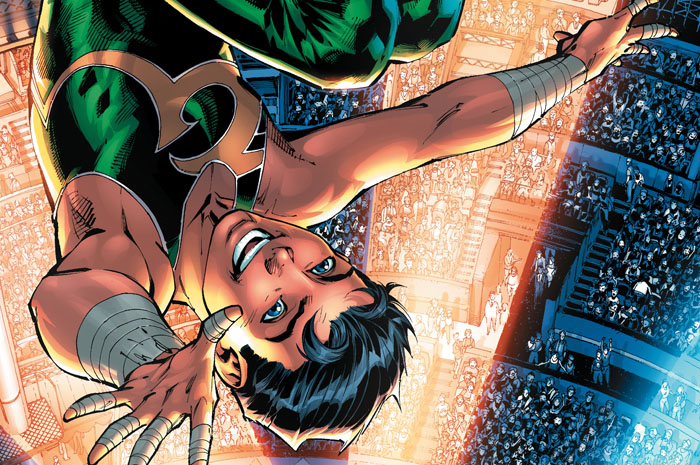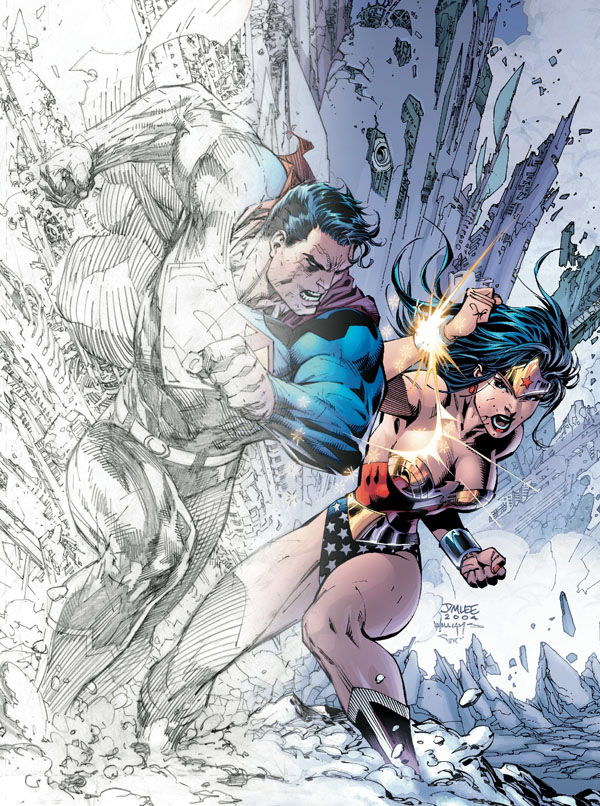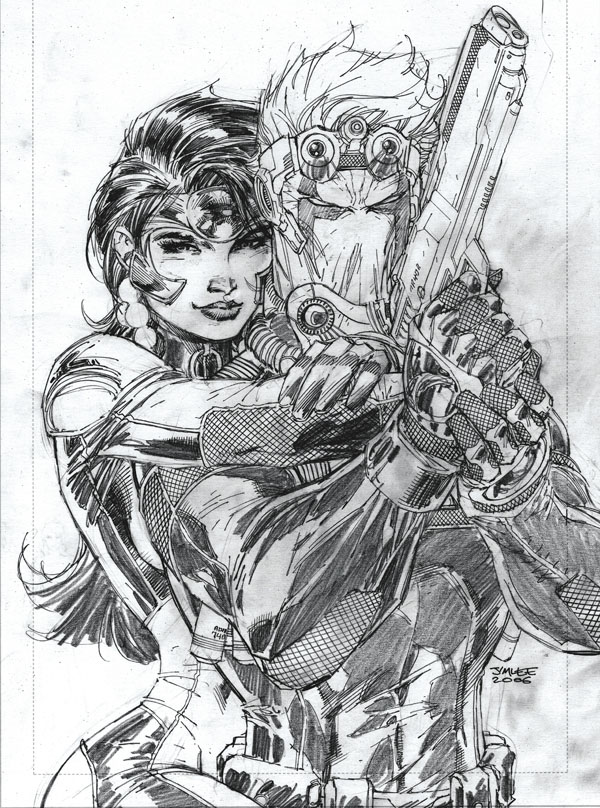Titan publishing put together one of the finest retrospective pieces of coffee table art book in Jim Lee’s ICONS. It’s a gorgeous collection and I’ve caught myself thumbing through it for hours on end because it’s so all encompassing of Jim Lee’s career with DC and Wildstorm.
It has plenty of art you’d recognize instantly and so much of the art behind those images that has never been seen.
Titan Books is offering an exclusive limited edition of the book available only through Amazon. These are deluxe versions of the book that are numbered and signed by Jim Lee himself. I’ve seen the line for his signings, trust me, this will be easier.
For the occasion, I was able to talk to Jim Lee about the book and his work at DC Comics.
Jim Lee: This book turned out great. It’s amazing art design and direction can do for someone’s work. These kinds of books are often, because they take a lot of the work that you’ve already seen and published it in periodic form and blows it up and crops it nicely and frames it and puts all the pencil and ink stages before and elevates the art to something more than what it started out as. And it starts as pictures that move a narrative forward and it takes single images and makes it seem more like Art with a capital “a”. It’s a bit of alchemy and highly appreciated by myself. It’s nice to see the work in that good of format.
Big Shiny Robot!: Titan did a great job with this book. What was the thinking… You’re one of the guys in charge of DC, why was the decision made to go with Titan instead of publishing it in-house?
JL: This book was actually started years ago, before I was co-Publisher. I’m pretty sure the logic on books like this was that they take a large amount of work and DC is really set up to create comic book stories, so we’re great at hiring writers and artists to put those kinds of things together. This is a different kind of project and we just license those out. That’s why you see that. There’s a lot of finding the art images, the sketches, more editorial and art direction work than DC is really designed to do.
BSR: What strikes you the most flipping through this book?
JL: I’ve done a lot more work than I thought I have. I normally don’t look back on the comics I’ve drawn, it’s usually only at conventions when fans bring them up for an autograph. Looking through it, I’m struck by the number of pieces I only vaguely remember drawing and some I don’t even remember. It’s my work by I really don’t remember the time and place. To me looking back on the work it’s more a history of my life versus the story that the images are pulled from. A lot of times, 90% of the time, I can remember a very distinct time and place where I did them, different circumstances. Like there’s a Batman Black and White cover I remember drawing in a hotel in Berlin at a store signing and they needed it right away and there’s other images I finished on a train or in an airplane and then the whole years worth of Superman: For Tomorrow, I did that while living in Italy, so I can distinctly remember each image with its own history. In a sense it’s a history of my life as much as images that have told stories that fans are familiar with.
BSR: I would say VERY familiar with. I owned a comic book store when Hush started and you really set the tone from 2002 to today. Even with what Grant Morrison did to change Bruce, the image and look you designed for Batman has really stuck around and defined the character for close to a decade. As a publisher maybe you have a different take on it than you did then?
JL: I don’t set out when I do the work to define anything. I think one of the choices an artist has to make when they start on a story or a run is what they love about the character visually and artistically. And I always loved the shorter ears and the bulkier Batman, but as I worked on the character he actually got longer ears and got more lean. So he kind of started out more of a Frank Miller, Dark Knight Returns and ended up more Neal Adams inspired. I think you make these decisions and you don’t know how the audience will take it, but you make these decisions based on your own internal compass. This was the version that I thought was the best. I really wanted to play up the blue and the gray. His roots are in full color comics.
BSR: The great thing about Hush specifically was that the story was so uniquely comic, where it was coming out month to month and customers would come in and we’d all discuss the possibilities of things. And I remember once a customer came in and said, “Jim Lee is a genius,” and it was right when you thought Clayface was the real Jason Todd and he went back and I guess in issue four or five you could see Hush standing on a building and I guess it was a Robinson’s building.
JL: Right.
BSR: It was very well thought out and very well put together and it could only be told in this medium.
JL: A story with this number of characters and the complexity of the storyline you could never do that in a two hour movie, for sure. That really is the beauty of the medium we work in, to tell longer form stories and have a richness and layers to it, but somewhere between a novel and a motion picture. Look at The Lord of the Rings, the book experience is completely much deeper than the movie and comics bring you to this rich middle ground where you can layer things and set up things in a number of different ways and involve so many different characters in the storyline and still have it make sense in a way you couldn’t do in a motion picture. The trick is figuring out how to fit that all into a story and make sure it makes sense. You look for ways just to dazzle the reader and I do that in slightly ironic ways. There’s actually a cover I did with Catwoman with her arms out and Batman is behind her in a graphic sort of vampire pose with poison ivy circling her. And Superman and Poison Ivy weren’t represented on the cover graphically, but I wanted to suggest them through the secret messages. The fans love that. You’re adding hints and alluding to things and they add a richness of depth you can’t see watching a motion picture because things are just flying by so quickly.
BSR: You’ve been an artist and a publisher for a long time and how has your day to day job with comics changed since you’ve become the co-publisher of DC, especially now that Wildstorm is being folded in to it in some way?
JL: It’s changed quite a bit, actually. I do a lot more press than I used to, and the press I did before was mostly confined to the work I did personally but because we’ve got a lot of new stuff, our digital initiative and the $2.99 price reduction, I do a lot of press for DC Comics. With the new executive team that’s leading, we’re really looking to unleash the power of DC Comics and better integrate it into all of these Warner Brothers divisions. There’s a lot of collaboration going on and there’s a lot of meetings with sister divisions of Warner Brothers and looking for ways to accomplish that directive. It’s creative, but it’s a very different kind of creative process than creating artwork or creating stories. It’s looking for opportunity, it’s looking for ways to maximise the characters we already have, and I’m enjoying it. It definitely exercises a different set of muscles…
BSR: What’s the next big thing we can expect from DC? Since you guys have taken over you’ve jumped into digital, you’ve brought the price point on the comics down, you’ve got your Vertigo titles, Scott Snyder’s American Vampire hit the New York Times Bestsellers list. What’s the next big thing both out of DC and what can we expect out of you, too?
JL: As a company, look for an expansion of our digital activities. Right now we’re authoring the existing backlist libraries and creating these authored .PDF files for people to view on iPads or their PSP’s and we’re looking to branch out into the digital space. On a creative level we’re trying to redefine what DC stands for and all the different characters starting in January 2011. That’s really going through a title-by-title basis and figuring out who these characters are and what they stand for and their reason for being out there. And I think that’s going to strengthen our whole editorial line. As for me personally, I’ve been working on DC Universe Online MMORPG. That’s four of five years worth of work and I’m very, very excited about it. Then there’s The Dark Knight, Boy Wonder which I’m working on with Frank Miller and Batman Europa which I’m working on with Brian Azzarello. It’s a mix of interactive stuff, digital stuff, and my own comic book artwork. I’m definitely keeping myself very, very busy.
BSR: As far as digitally, how quickly to you guys see yourselves expanded your back catalogue? DC has a richer, longer history of things people want to see digitally, how quickly will we see this ramped up so we can see a comprehensive archive?
JL: That really is the question. We have so many years of publishing to draw on that we’re trying to hit the highlights and have a nice mix of older material and more recent material and day and date material. We have our trade paperback program, so we can’t flood the market and convert them all at once. We’ve been doing a mix of things that people will be familiar with because they’ve seen the characters in video games or TV shows or animation or movies. And then we have some of our classic storylines to put out. And then also some more recent work that helps support our efforts going forward. For instance, we have the Green Lantern movie debuting this year, so our library is expanding on existing Green Lantern stories and we’ll have a lot of that out there when the movie hits and capitalize on the awareness of that character. We’re definitely putting out more each month and looking to add to that with new material.
BSR: With Green Lantern coming, are you guys going to be cross promoting? In the past, the comic and movie divisions of all the publishers have had a hard time doing a cross-promoted effort to bring readers to the movie and passive movie viewers to the comics. What do you guys have planned for Green Lantern as a character in the comics as a way to bring some of those movie viewers into the medium?
JL: I think that’s a big proposition that we have on the digital side. If people love the movie and we expect that they will try to find out as much as they can about the character on their mobile devices and on the internet. And that should eventually lead a lot of them to our digital efforts and be able to download the best Green Lantern storylines to their phones or computers. And we want to convert those readers into comics fans and we want to help them discover that there are comic book shops that sell this material and find the toys and statues and that all kind of thing. And we really want to market and cross-promote this movie across all the different activities that we do. So you’re going to see direct toys, digital comics, cool events on the print side, and a video game that’s supportive of the movie. So this is really one of our directives, is to be better integrated and working more in concert with other divisions of Warner Brothers and theatrical is one of the big ones, if not the biggest.
BSR!: When you guys launched digital, one of the things you guys hinted at that everyone was really excited about were incentives for retailers funded and promoted by the digital side. What new stuff do you see coming up with that that you can talk about that will help get people to download comics digitally into a comic book store and buying trades and buying the new print issues?
JL: There are a number of initiatives we’re working on. We’re looking at e-couponing. We’re looking at ways to improve the Comic Shop locator service that already exists within the app itself, through the DC Comics app. And we’ve looked to the advice and input of a large number of the countries best and largest retailers, looking for ways to further bring them into the loop. There are things we’re exploring on the content side where stories will start out digitally and end up in print in the store. And we’re looking for ways that reward fans that are buying print with perhaps digital copies of their books. There are a number of ways we can do it, we’re confident we can do it, and we wouldn’t do it if we didn’t think we could help our brick-and-mortar partners and expand the overall size of the pie, of the retail marketplace.
And that was all we had time for, but I would definitely check out the book. Here is the regular version, and here is the limited edition.



